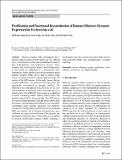Purification and functional reconstitution of human olfactory receptor expressed in Escherichia coli
Author(s)
Yang, Heehong; Song, Hyun Seok; Ahn, Sae Ryun; Park, Tai Hyun
Download12257_2014_Article_897.pdf (522.7Kb)
PUBLISHER_POLICY
Publisher Policy
Article is made available in accordance with the publisher's policy and may be subject to US copyright law. Please refer to the publisher's site for terms of use.
Terms of use
Metadata
Show full item recordAbstract
Olfactory receptors (ORs), belonging to the Gprotein coupled receptor (GPCR) family, are very difficult to be overexpressed, purified and reconstituted because of their hydrophobicity and complicated structure. These receptors bind to their specific ligands, thus their specificity is very useful for application as a bioelectronic nose. Furthermore, highly purified and well-reconstituted human olfactory receptor (hOR) can be used in various fields, such as in protein-interaction research, drug screening, and analysis of the hOR structure. In this study, human olfactory receptor, hOR2AG1, was produced with high purity and functionally reconstituted in detergent micelles. The hOR2AG1 was overexpressed in Escherichia coli (E. coli) with glutathione S-transferase (GST) and 6xHis-tag as an inclusion body. The hOR2AG1 fusion protein was solubilized in buffer containing sodium dodecyl sulfate (SDS) and purified using Ni-NTA chromatography. The GST domain was removed using proteolytic cleavage before elution from the column. After purification, the hOR2AG1 was successfully reconstituted using nonionic detergents and methyl-ß-cyclodextrin. Finally highly purified and well-reconstituted hOR was obtained, and its biological characteristics were confirmed by using circular dichroism (CD) spectrum and tryptophan fluorescence assay. These results can be applied to develop protein-based sensing systems including a bioelectronic nose and to analyze the native hOR structure using solid-state NMR, X-ray crystallography, or neutron scattering.
Date issued
2015-07Department
Harvard University--MIT Division of Health Sciences and TechnologyJournal
Biotechnology and Bioprocess Engineering
Publisher
The Korean Society for Biotechnology and Bioengineering
Citation
Yang, Heehong et al. “Purification and Functional Reconstitution of Human Olfactory Receptor Expressed in Escherichia Coli.” Biotechnology and Bioprocess Engineering 20.3 (2015): 423–430.
Version: Author's final manuscript
ISSN
1226-8372
1976-3816